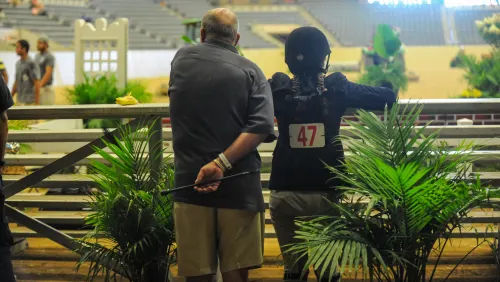I can sit and watch any horse sport done well. I love horses (news flash!), but more than that, I love dressage. And because I’m a huge nerd, I love seeing how dressage plays a role in all the other sports, that the basic tenants of training that I preach to my students apply to other disciplines.
Recently I had the great pleasure of a pairs driving lesson. A student of ours has been involved in pairs driving at the top level for years, and is now coming to dressage, but has a fantastic pair of cremello Morgan mares in training for whom we did some complementary under-saddle training, including the world’s cutest Pas de Deux last year. I hopped up in the cart to take them for a spin, starting out just puttering around in the open, and then tackling cones (at which I was marginally awful), and even a few basic marathon obstacles (which went much better).
If you don’t know anything about combined driving, here’s the Reader’s Digest version: it’s a lot like eventing, with a dressage test for Phase 1; a second phase through natural obstacles and water, timed, called marathon; and the third phase, cones, like show jumping, with a pair of cones with tennis balls on top of them through which the entry must drive, and if the ball falls, it’s 4 faults, just like a rail.
And here’s where dressage comes in handy: it’s all about the outside rein.
So many of us were taught, as tiny peanuts in our first riding lessons, that pulling the horse in the direction you want him to go is how to turn. It’s called a direct rein, and it often works… but not always. Horses have long necks, and as such, there’s no guarantee that the rest of the horse’s body is going to follow his nose. How do horses spook or shy? By pointing their heads at the thing from which they’re fleeing, to keep an eye on it, while the torso and legs peace out in the opposite direction.
Enter the outside rein. Steering by using the leather of the outside rein against the neck turns the shoulders in the direction of travel. The butt has no choice but to come along.
The same is true of driving, I now know. Bringing the outside shoulder of the outside horse around meant success. Trying to steer the inside horse to where I wanted to go meant instant failure.
ADVERTISEMENT
Where driving is different from dressage is—duh—no legs on the horse. But driving horses learn to accept the pressure of the whip in the same way that our horses learn to accept the leg. Whip up towards the “saddle” (driving term for what I would call a surcingle, the part that goes around the horse’s belly and back) talks to the midsection of the horse, and addresses bend and posture. Whip on the bum tells the horse to go more.
A while back I taught a clinic in which a woman rode side-saddle, and she let me hop on and try it. It was totally cool, and the whip was used the same way, along the girth of the side to which the lady’s leg does not fall.
I had a total blast, and am seriously considering running away and joining the driving circus. And I was also inspired, as I always am when I meet riders from other worlds, by how much we can learn from other disciplines. My event riders teach me courage. My jumpers and fox hunters show me that instinct is an important quality in a horse. One of the best explanations of a half-half I’ve ever heard was from a natural horsemanship, cowboy type.
The equipment may be different, but the rules are all the same. Pressure, then yield. Inside leg to outside rein. Praise often. Break problems down to their most basic parts. And quit while you’re ahead. (Also, ibuprofen. A beautiful thing. Hello, triceps!)
Thank you to Heather and Marco for a hugely fun adventure!















